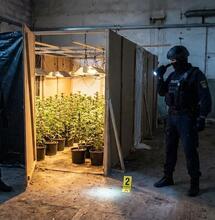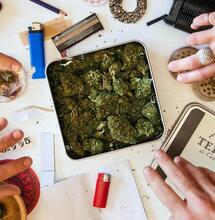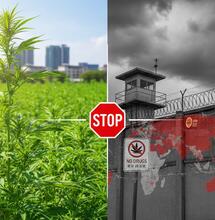How to Grow White Widow?

White Widow is arguably the most potent cannabis hybrid strain that emerged in the 1990s in the Netherlands, thanks to its creators, Green House Seeds. White Widow took the Amsterdam scene by storm and quickly became a favorite among growers worldwide. Examining its genetic lineage, White Widow has Brazilian and South Indian roots. It is 60% sativa and 40% indica, with a THC content ranging from 18% to 25%. Even after all this time, many growers still prefer White Widow—the matriarch of the 'White Family'—over other 'white' cultivars.
Why White Widow Remains One of the Most Iconic Cannabis Strains
White Widow is recognizable by its highly resinous buds, the main reason for the strain's exceptional potency. It is the most famous and successful Dutch hybrid to emerge in the mid-1990s. Skunk #1, Northern Lights, Afghan and Haze strains dominated the market before the arrival of White Widow. Enter White Widow in 1995, it was a game-changer to have such a complex, sativa-dominant blend that appealed to growers at all levels of expertise. While there might be some difficulties growing this cannabis strain, most of it is manageable.
Genetics: White Widow is typically a 60% sativa and 40% indica. A potent match between a Brazilian sativa landrace and a resin-heavy South Indian indica. The queen mother of the 'white' family of cannabis strains, White Widow borrows its genetics to other powerful strains such as White Russian, White Rhino, and Blue Widow.
Taste and Flavor: A woody and earthy sensation—occasionally with a hint of spice—will evoke a familiar feeling among those who have been toking for a while now.
Terpenes: The dominant terpene in White Widow is myrcene, which is commonly found in cannabis and other vegetation such as hops and bay.
Effects: White Widow is a highly potent strain that offers an excellent, well-balanced high that affects both the mind and the body. A feeling of euphoria follows the initial cerebral high. It’s an incredible strain to socialize or to undertake creative activities. It will keep you up and high for the next couple of hours.
Side Effects: In addition to the typical dry mouth and dry eyes, White Widow may cause mild feelings of paranoia in some users. If this sensation persists, it might be wise to try a different strain.
Medical Uses: White Widow is often used to help manage conditions such as ADD/ADHD and PTSD. Many users also rely on it to reduce stress and relieve mental tension.
Growing Difficulty: Even though White Widow can be somewhat finicky, it’s still quite manageable—even for growers with limited experience. This strain thrives especially well at higher elevations, where the environment can be particularly soothing for its growth. While the flowers can tolerate warmer-than-usual temperatures, prolonged exposure to cold can cause significant damage.
Growers may encounter different phenotypes of White Widow. The more sativa-leaning varieties, which tend to grow slender and tall, are particularly well-suited for indoor cultivation.
Flowering and Harvest: Indoors, White Widow flowers in about 60 days, yielding roughly six ounces of bud per plant. Outdoors, flowering completes in around 75 days, with harvest typically taking place between late September and early October. Outdoor crops generally produce slightly higher yields than indoor ones.
To determine the right harvest time, use the pistil method. The rule is simple: wait until at least 70% of the pistils have turned amber before collecting the rewards of your hard work.

How to Grow White Widow Cannabis?
Using the SOG or SCROG grow techniques is more than recommended when planting White Widow gardens. Ensure that you limit vegetation time a little more than you would with a typical 60/40 if you go down the SOG/SCROG road. That will allow for a robust, energetic pre-flower phase—a differentia specifica moment when cultivating the original White Widow.
As a low-stress training technique, Screen of Green will increase the number of colas your White Widows are due to produce. Set the canopy in your grow room and allow time for the plants to outgrow the mesh. Once the branches begin to protrude, tuck them back into the screen. As the plants enter the flowering stage, you will notice an increasing number of bud sites.
During the growing process, you may want to re-pot your White Widow crops. Do this when you see that the plants have outgrown their original containers. Transplanting them into larger pots will ensure healthier roots and stems.
White Widow will thrive both in soil and in hydroponic systems. Either way, you are in for a great growing adventure and a luscious harvest.
How to Recognize Phenotypes?
Since its appearance, there have been numerous hybrids and versions of the White Widow strain taking over the markets. Many old-school growers familiar with Dutch genetics claim that one way to tell you are growing the original Widow is its inclination to pre-flower during vegetation. This occurs thanks to White Widow's Brazilian lineage.
As mentioned earlier, sativa-oriented phenotypes grow into more slender plants, which benefits indoor growers. With distinctly sativa-leaning phenotypes, the grow room is easier to ventilate, and there’s less risk of humidity issues or plants struggling with mold and mildew. You can still apply low-stress training and keep your plants short and stocky without affecting yields.
The main traits of the more indica-dominant phenotypes are dark green leaves that appear unusually narrow, much like those of sativas. These plants display an even more noticeable white glow when light is refracted. Their opalescent colas eventually give way to amber or reddish-brown pistils as the flowers begin to mature.
How to Set the Grow Lights for White Widow?
White Widow plants should remain in their vegetative stage for around eight weeks. One recommendation is to expose the plants to a minimum of 18 hours of light per day throughout this period. Ensure that the light focuses low on the plant, but be cautious not to burn the tips.
Switch to a 12-12 light regime once you are past the eight weeks. The extended period of darkness at this stage will trigger flowering. This is also the recommended time to implement the SCROG method. Make sure the light is distributed evenly around your flowers to get the most out of your harvest.
Another tip for your lights? According to the Big Book of Buds, “Green House suggests changing the lighting to eight hours during the last two weeks of flowering in order to halt regrowth... on the buds and produce just enough stress to coax out the maximum amount of sticky resin per inch.”
How to Regulate Temperature and Humidity?
White Widow is a strain that can tolerate higher temperatures quite well but doesn’t respond favorably to cold conditions. Even when exposed to temperatures above 80°F, White Widow can continue to function normally. However, it won’t perform well if overexposed to cooler temperatures, such as 55°F.
The optimal temperatures for outdoor White Widow plants are above 70°F during the day and above 60°F at night. Indoors, temperatures can reach up to 95°F, provided that the grow room is supplemented with carbon dioxide enrichment of around 1500 ppm.
As for humidity, maintain around 70% during germination and reduce it to 65% during vegetation. Once flowering begins, gradually decrease humidity by about 5% each week until you reach approximately 35%.

How to Feed White Widows?
Use higher amounts of nitrogen during the vegetative stage of your crops, then reduce this essential nutrient during flowering. White Widows require more phosphorus and potassium during flowering, as these elements help build higher THC content.
Plants will also benefit from sulfur, calcium and magnesium, and they also need trace amounts of micronutrients such as iron, zinc, copper, boron, etc.
Remember to stop dispensing nutrients when your White Widows are two weeks away from harvest to preserve the plant’s herbal, spicy taste.
Water your White Widow plants once a week, or more frequently (e.g., every four days) if you have improved drainage. Adding perlite or lava rock to the growing medium can significantly enhance drainage.
Finally, regarding pH levels, White Widow can tolerate up to 6.5. For hydroponic setups, the pH should be about 0.5 lower.
Are Pests a Threat to White Widow Plants?
For most of the time, White Widow is pretty resilient to pests, however, there are instances when this strain appears vulnerable to spider mites, aphids, whiteflies, caterpillars, fungi, or bud rot.
Sticking to the temperature and humidity guidelines above will help prevent bud rot or fungal growth on this cultivar. Plants are most vulnerable when flowers begin to form. A combination of temperatures around 70°F and high humidity poses a particularly high risk for White Widow grown indoors.
When growing outdoors, maintain your crops with homemade solutions or non-chemical deterrents. If you bring plants indoors, inspect them carefully to avoid introducing pests. Wipe each leaf with a protective solution to keep unwanted insects at bay, ensuring a healthy and bountiful White Widow cannabis harvest.
More grow guides from Soft Secrets:














